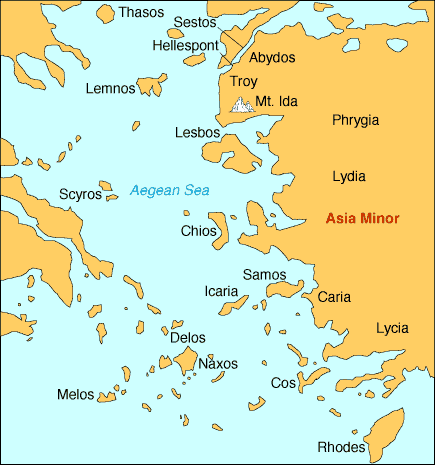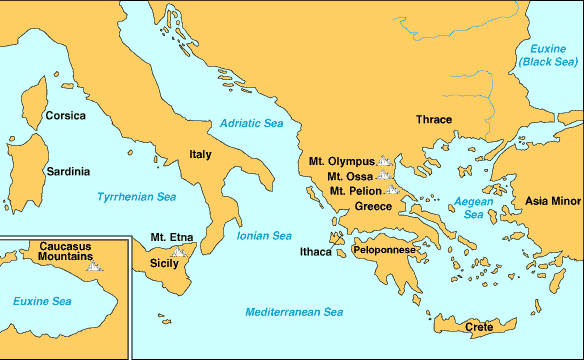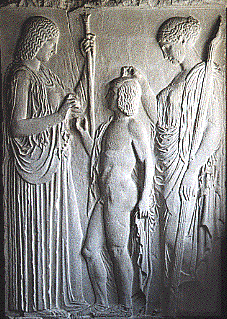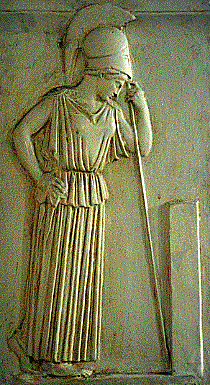


On the Cycladic islands archeologists find many stylized female figurines, datable from 3200 to 2000 BC. Usually found in grave sites, these so-called "cycladic idols," with their white bodies, featureless faces, and stiff, formal poses with arms folded, are often thought to represent the goddess in her death-aspect. However, the prominent breasts, clearly marked pubic triangles, and pregnant bellies (of some) of these same figures may also indicate the rebirth promised by the goddess. From the material evidence it is apparent that the mother goddess represented the power of the earth to give birth to the living, to cover over the dead, and to transform death into rebirth in an endless cycle of the seasons. Often, the goddess was associated with earth-symbols like caves and cyclical symbols like the moon or snakes, who emerge from the sacred earth and shed their skins, renewing themselves much as the earth does. On Crete, the goddess continued to be worshipped in caves even after the Minoans had developed an advanced urban culture.
The goddess-worshipping people on the mainland and the islands seem to have been peaceful farmers and traders: the palace-city of Knossos on Crete has no walls around it. As such, they were probably no match for chariot-riding, armored invaders. On Crete, we find the most advanced and the latest (2500-1450 BC) civilization of the goddess, called Minoan, after the mythical King Minos. The floor-plan of the palace at Knossos is a complicated agglomeration of rooms and skylights. The palace features vast storage rooms for wheat, olives, and wine, elegantly painted apartments and throne rooms, and even indoor plumbing. Statues, seals and wall paintings show bare-breasted goddesses adorned with snakes and depicted with double axes, trees, poppies, bulls, and lions. Wall paintings at Knossos show young men and women leaping over bulls. The bull was probably associated with male fertility, while stylized representations of its head and horns may represent the female vulva. The double-axes are real and symbolic slayers of the bull, indicating ritual sacrifice. They are never shown in the hands of a male god (Nilsson 223). The shaft of the double-axe is sometimes shown sprouting leaves, while the shape of its head can look like two halves of a crescent moon, another symbol of cyclical nature. The double-axe was called a labrys. Later, the Greeks named the maze-like structure of the palace at Knossos the labyrinth, or House of the Double-Axe. Greek myth says that King Minos had his master craftsman Daedalus build a labyrinth, or maze, in order to imprison the Minotaur, a monster half-bull and half-man, the product of an illicit union between Minos’ wife Pasiphae and a sacred bull. The Minotaur was eventually slain (some say with a double-axe) by the Athenian hero Theseus.
Since the earth goddess was the main object of worship on Crete, her sanctuaries were located in places associated with the earth: "on mountain-tops, in caves, or in temple-chambers of the palaces" (Davies 89). In 1628 BC, disaster struck Minoan civilization: a massive earthquake, the result of a huge volcanic eruption about 100 miles north on the island of Thera in the Cyclades, caused considerable damage throughout Crete, destroying the trading fleet and weakening the social structure. From their relatively high vantage point at Knossos, the priests could have seen the massive plume of smoke, fire, and ash to the north. In a cave nearby on Mount Juktas, the priests prepared a human sacrifice to appease the Earth:
The Myceneans were Greek-speaking warriors, very likely descendants of those who invaded the mainland in 2200-1900 BC. They were centered around the citadels of Tiryns and Mycenae, situated atop high hills and fortified with massive "cyclopean" stone walls. Kings and nobles were buried in splendor, with gold ornaments, tripod cauldrons, and swords and daggers, in huge domed "beehive" shaped tombs built into hillsides. Despite conquering the Minoans, the Myceneans traded with them and prized their superior craftsmanship. The Minoans traded widely and may have taught the Myceneans how to build ships. Though written much later, Homer's epic the Iliad gives an account of the most famous Mycenean raiding expedition to Troy, in Asia Minor. According to tradition, Agamemnon, the king of Mycenae, assembled a massive Greek fighting force to avenge the abduction of Helen (his brother Menelaus' wife and the most beautiful woman in the world) by a Trojan prince named Paris. The Trojan War is supposed to have occurred around 1200 BC, but no one knows for sure whether the traditional Homeric account of the war is accurate or even whether a king of Mycenae named Agamemnon ever existed. We do know that Homer's version of events sometimes contains details from a later time. For example, he mentions iron, which was introduced into Greece after the Trojan War, around 1000 BC. Another example: in Homer, the dead are cremated and buried in urns, while during the Mycenean age unburnt bodies were buried in elaborate tombs. Homer consistently stresses the warlike, sky-god aspect of Greek religion, ignoring the more peaceful earth goddess elements inherited from the Minoans. However, we will see how the female side of the religion both threatens and assists the hero of the Odyssey, and later in the semester we will read about an earth goddess named Demeter ("earth mother") who is directly descended from earlier mother goddesses.
Around 1200-1100 BC, a new group of Greeks called the Dorians invaded the mainland and destroyed the palace civilization of the Myceneans. The resulting period is called the Dark Age (1200-750 BC) because material culture declined, and no new palaces or massive walls were built. Probably the power of kings declined at this time, too, along with travel, trading, and raiding. And since there was no further need for palace inventories, the Greeks forgot the old linear B script. Towards the end of the dark ages, geometrically-patterned pottery that is recognizably Greek begins to appear, along with a new form of alphabetic writing, borrowed after trading with the Phoenicians. During this time, the oral tradition preserved tales of Mycenean splendor, the best of which were attributed to Homer and written down sometime around 725-675 BC.
Besides Homer, one other writer, named Hesiod, has been preserved from the end of the dark age and the beginning what is known as the Archaic Age (750-500 BC). Hesiod sang of the birth of the Greek gods in his poem the Theogony. According to Hesiod, the world began with Chaos, Greek word for "abyss":
As soon as each of his children was born, Ouranos stuffed them "back into a hollow of Earth . . . / Keeping them from the light, an awful thing to do" (157-158). Naturally, Earth felt a bit uncomfortable with twelve Titans stuffed inside her. She showed her son Kronos a big sickle, and he promised to get even with Ouranos. The next night, Kronos waited in ambush when Ouranos "longing for love, . . . settled himself all over Earth" (178). Then:
Now king of the gods, Kronos married his sister Rhea, and she gave birth in succession to six major Greek gods (called Olympians): the goddesses Hestia, Demeter, and Hera and the gods Hades, Poseidon, and Zeus. Like his father Ouranos, Kronos also disliked his offspring. But instead of stuffing the kids back into the earth like his father did, Kronos swallowed them as soon as they were born. His wife Rhea naturally took offense at her husband's arrogant behavior, so she conspired with her mother Gaia (Earth) to hide the last-born child Zeus in a cave on Crete. (This detail of the sky-god Zeus being hidden in a cave on Crete by two mother-goddesses is yet another survival in mythical form of the meeting of the two religious traditions.) When Kronos asked to swallow his last-born child, Rhea tricked him by giving him a stone wrapped in swaddling clothes to swallow as a substitute for the infant Zeus. Later, when he defeated his father, Zeus somehow (Hesiod doesn't say exactly how) forced Kronos to throw up the stone along with the other swallowed children (Hestia, Demeter, Hera, Hades, and Poseidon). In ancient times, locals at Delphi pointed to a huge stone which they claimed was the one that Kronos threw up. Some of the major Greek gods are:
Zeus, son of Kronos (Cronus) [Latin Jupiter or Jove], King of the gods and thunder god. Just as Kronos overthrew his father Ouranos (Heaven), Zeus overthrows his father Kronos, imprisoning him deep in Tartaros. In order to prevent his own son from overthrowing him, Zeus swallowed his first wife Metis ("cunning intelligence") before she could give birth to a son who might be a rival for the throne. However, since Metis was already pregnant with a girl (Athena) when Zeus gobbled her up, Athena had to be born from Zeus' head. (Hephaistos assisted this difficult delivery.) After Zeus consolidated his rule and ended the successive overthrows of fathers by sons, he spent most of his time chasing goddesses and mortal women and settling disputes among the gods. Zeus' symbols: thunderbolt, eagle. Bronze statue: Zeus or Poseidon.
Hera [Latin Juno], Zeus' wife and sister, patron goddess of Argos and Samos; goddess of marriage. Symbols: crown and veil.
Hestia, goddess of the hearth. Though important in everyday
life, little is written about this goddess with the exception of two brief
Homeric Hymns (#24 and 29).
 |
Demeter [Latin Ceres], goddess of grain (wheat), of agriculture,
who mourns her daughter Kore or Persephone, abducted by Hades. Her
name means "earth mother." Demeter gave birth to Ploutos, the god
of wealth, after lying with the Titan Iasius or Iason "in a thrice-ploughed
field in the rich land of Crete" (Hesiod 88). Why do you suppose
wealth is associated with Demeter and the earth? Symbols: torches,
ears of wheat.
Persephone or Kore ("the Maiden") [Latin Proserpina], daughter of Demeter and Zeus, abducted by Hades, Queen of the underworld and embodiment of the returning spring. At left: Demeter, Triptolemus, and Persephone. Relief from Eleusis, 440 BC. Vase painting: Demeter
and Triptolemus with wheat
|
Hades [Latin Pluto], brother of Zeus, ruler of the underworld and husband of Persephone. The Romans confused Hades with the Greek god of wealth, Ploutos. Why do you suppose that happened?
Poseidon [Latin Neptune], brother of Zeus, god of the sea, earthquakes,
and horses. Often called "the Earthshaker." Notice that Zeus,
Hades, and Poseidon divide up the universe among them: Zeus controls
the sky and earth, Poseidon the sea, and Hades the underworld. (See
Iliad p. 393, lines 220-238.) Symbols: trident, horse.
 |
Athena (sometimes called "Pallas") [Latin Minerva], daughter
of Zeus and the swallowed Metis, born from Zeus' head (Hesiod 85-87).
She is the goddess of the strategic, tactical side of war, of handicrafts
like spinning, weaving or pottery making, and of ingenuity, resourcefulness,
and wisdom in general. Why is it not surprising that she loves Odysseus
best among the mortals? Despite being a maiden (parthenos), she is
the descendant of a local mother goddess, as the snakes and gorgon head
on her costume and her position as protector of Athens indicate.
At first, Poseidon claimed Athens as his own by "thrusting his trident
into the acropolis" (Graves 59) and causing a spring of water to gush forth.
But Athena won the hearts of the citizens by planting the first olive tree
on the acropolis. Symbols: helmet, spear, olive tree, owl.
Athena Image Links: |
Hephaistos [Latin Vulcan], son of Zeus and Hera, lame blacksmith god. Hephaistos once made some armor for Athena. Abandoned by Aphrodite and having been told by Poseidon that Athena couldn't wait to go to bed with him, Hephaistos tried to make love to Athena. Being a chaste and modest goddess, she naturally refused his advances. "He ejaculated on the leg of the goddess and she in disgust wiped off the sperm with a piece of wool and threw it on the ground" (Apollodorus 203). One of the first kings of Athens, Erichthonius ("much earth" or "strife with earth") was born from the sperm thrown on fertile Mother Earth. Wishing to avoid a scandal and to make the child immortal, Athena reared Erichthonius in secret, but the secret was discovered when two daughters of the king of Athens opened the sacred basket where he was kept and saw to their horror that the child had a serpent's tail. Symbols: hammer, fire.
Ares [Latin Mars], the god of battle and slaughter. Ares was not good at tactics like Athena, and often, he represented the capricious and sudden changes of momentum and luck in battle. He doesn't seem to have been a particularly well-liked god, but nonetheless he was worshipped. Why do you suppose that is?
Apollo, son of Zeus and Leto, god of prophecy, purification, healing, and the decorous music of the lyre. (Sometimes called "Phoebus" or "Paeon.") Apollo was born on the tiny island of Delos, in the center of the Cycladic islands (called cycladic because they form a circle: Greek, kyklos = "circle"). He came into possession of his shrine at Delphi by shooting with his bow and killing the serpent Python by the sacred chasm of Mother Earth. (Another sky-god takes over a shrine of the earth.) For this murder, Zeus ordered that Apollo be purified. (The ancients believed that anyone who had shed blood was somehow polluted or defiled and thus needed to be purified. Purification rituals were many, but often supplicants were doused with incense, water, and / or the blood of a sacrificial animal.) Apollo (together with his sister Artemis) also killed the giant Tityus, who had made the mistake of trying to rape their mother Leto. When Apollo sends plague or death, he is depicted as shooting people or animals with his arrows. How do you suppose the god of purification and healing can be associated with murder and plague?
Apollo's shrine and oracle at Delphi was a famous Greek institution. It was called the "navel of the world" because it was near the center of the Greek landmass. People would bring gifts to the priestess (called the Pythia) and ask her about the future. She would mumble some archaic words which the priests would translate into a short Greek poem. Her answers were often rather clever or ambiguous. Ask me sometime to tell you about the answers she gave to Croesus, King of Lydia and to Socrates the philosopher.
Apollo, who plays the lyre, was once challenged to a musical contest by the satyr Marsyas, who played a shepherd's flute. (A satyr is a woodland deity with pointy ears and a horse's tail. Satyrs often behave quite licentiously.) The goddesses of poetry and song, the Muses, judged the contest and couldn't decide on a winner until Apollo challenged Marsyas to turn his instrument upside down and play and sing at the same time. Of course, Marsyas could not possibly meet this challenge while playing a flute, and so Apollo was judged the winner of the contest. Then, Apollo took revenge upon Marsyas for having the gall to challenge him: he flayed Marsyas alive and hung his skin on a pine tree. Click here for an image of Apollo twisting a centaur's ear
Once, Apollo's son Asclepius, a famous physician, resurrected a dead man. This was quite a feat, but Hades did not like losing one of his subjects, so he complained to his brother Zeus who promptly zapped Asclepius with a thunderbolt, killing him. In revenge, Apollo killed the Cyclopes who had given Zeus his thunderbolts in the first place. Zeus wanted to banish Apollo to Tartaros forever, but was persuaded by Leto to reduce his sentence to one year's labor in the sheepfolds of King Admetus of Thrace. Perhaps because he had finally learned his lesson, Apollo was known as the god of moderation, of the civilized music of the lyre, and of behavior. On his temple at Delphi was engraved, "Know thyself" and "Nothing in excess." Apollo's symbols: lyre and bow.
Artemis [Latin Diana], Apollo's sister, goddess of the hunt and protector of wild animals and chaste women. She is chief of the nymphs, who are female spirits of the forests and streams. Called the "Mistress of the Animals" in the Iliad, Artemis was originally a goddess of the wilds who provided hunters with their prey. Walter Burkert says that at times, she was even depicted with a terrible, death-dealing Gorgon's head (149). Later, Artemis was seen as a holy, inviolable virgin, which Burkert says could symbolize two things: 1) virgin nature and/or 2) an ancient taboo forbidding sexual activity before a successful hunt (150).
Once, while out hunting, a mortal named Actaeon chanced to see Artemis bathing in a stream. Artemis saw him looking at her naked body, and for this act of impudence, she splashed water in his face, and turned him into a stag. Poor Actaeon was now fair prey for his own hunting dogs who chased him down and tore him to pieces. Vase paintings: Artemis as "Mistress of the Animals".
Hermes [Latin Mercury], son of Zeus and the nymph Maia. Messenger of the gods, god of roads, doorways, luck; guide of souls to the underworld, patron of shepherds, athletes, thieves, and among the Romans, merchants. Hermes' name simply means "a boundary marker," at first a heap of stones and later a stone pillar. Often in ancient Athens, these boundary markers (called herms) were surmounted by a bust of Hermes and decorated with an erect phallus. Most likely, the function of the phallus was apotropaic--meant to ward off or "turn away" evil spirits or daimons--or perhaps thieves. In this sense, it meant something quite similar to what an extended middle finger means today. But, as Walter Burkert points out, the god of boundaries was also a crosser of boundaries--trickster-thief, messenger of the gods, and guide of dead souls to the underworld (156-158).
The Homeric Hymn to Hermes tells how he once stole some cattle from Apollo, but he made up for it by giving Apollo the lyre, which he invented by using a tortoise shell as a sounding box. (See Sargent 30-31 and 41-43.) Besides these adventures, Hermes was also once involved in one of Zeus' many love affairs. Zeus was in love with a woman named Io, but Hera turned her into a cow and sent a giant named Argos to guard her. Argos was a good watchman because he had eyes all over his body and thus could keep some eyes open while other eyes slept. Zeus sent Hermes to get rid of Argos. Hermes charmed Argos with his magic staff (called the caduceus), put all his eyes to sleep, and then killed him. (That's why Hermes is called Argeiphontes, or "Argos-killer.") Zeus still didn't get to enjoy the company of Io, however, because Hera sent a gadfly to sting the poor heifer into fits of distraction. Goaded and stung by the gadfly, Io traveled along the west coast of Greece by the Ionian Sea (get it?), through northern Greece, across the Bosphorus ("Ford of the Cow") into Asia Minor, and eventually ended up in Egypt where Zeus finally released her from her torment and fathered a child by her. Along the way, according to Aeschylus, she stopped by to chat with the chained-up Prometheus, another soul tormented through the whim and power of Zeus.
Aphrodite [Latin Venus], the goddess of love and beauty. Sometimes she is called "Cypris" or "Cythera" because after her famous birth in the sea, she skirted the coast of Cyprus and finally came ashore on the island of Cythera. Some writers say that she was not born in the sea, but rather was the daughter of Zeus and Dione, a minor goddess.
Aphrodite was married to the lame smith god Hephaistos, but sometimes had affairs with other gods. Homer tells the humorous story of her affair with Ares the battle god in book VIII the Odyssey, so I won't repeat it here. Why do you suppose the sexy Aphrodite married the deformed Hephaistos?
Aphrodite had a magic sash (something like a bathrobe tie which held her flowing Greek garments together). Aphrodite was reluctant to loan out this sash, because whenever anyone wore it, she became irresistibly attractive.
Aphrodite once fell in love with Anchises, the King of the Dardanians. She visited Anchises disguised as a Phrygian princess and they made passionate love together. After making love with Aphrodite, Anchises realized that she was no ordinary mortal woman. Disturbed and fearful of such intimate contact with a goddess, Anchises pleads with her "not to condemn me to live as a weakling among mortal men / But have mercy on me, for impotence is the lot / Of the unlucky man who lies with an immortal goddess" (Sargent 50). She assured him that he had nothing to fear, and promised that their son (the future Aeneas) would be famous. Unfortunately for Anchises, he boasted that he had slept with Aphrodite, and for this slip-up, Zeus launched a thunderbolt at him. However, Aphrodite deflected the bolt with her magic sash, and Anchises was merely paralyzed from the waist down.
Dionysus [Latin Bacchus], son of Zeus and Semele, god of the vineyard and of wine, of emotional release, and drama. (Sometimes he is called "Bromius" and his followers are called "Bacchae.") He is often depicted in the company of his tutor Silenus (part goat), and a wild troop of Satyrs (part horse) and Maenads (intoxicated wild women). The Maenads are often dressed in the skins of fawns and goats and carry a thyrsus, an "ivy-twined staff tipped with a pine cone" (Graves, Vol. I 104). What are some possible symbolic meanings for the thyrsus? Click here for an image of Dionysus and a satyr
Dionysus was born in a peculiar manner. Disguised as a mortal, Zeus had an affair with woman named Semele, and it went well until Hera found out. Hera disguised herself as an old friend of Semele's and urged her to ask her mysterious lover to reveal himself "in his true nature and form" (Graves, Vol. I 56). Semele, who was already six months pregnant, asked Zeus to reveal his godly power in all its glory. When Zeus refused, Semele denied him further sexual favors. In a fit of pique, Zeus then appeared to her in "his true form," or as thunder and lightning. Semele was zapped to a crisp, but Hermes saved the six-month embryonic Dionysus, and sewed him up in Zeus' thigh. In three months, the infant Dionysus was born. He is often called "twice-born" because of this strange double nativity.
When he was a young god, Dionysus traveled around the Greek world to spread the news of his divinity and worship. Once, he booked passage incognito aboard a merchant ship that was supposedly bound for the island of Naxos. But the sailors turned out to pirates, not merchants, and they tried to kidnap Dionysus in order to sell him as a slave. The poet Ovid (who calls the god by his Roman name, Bacchus) tells us what happened next:
Sometimes in his travels, Dionysus encountered resistance to his cult of madness and emotional release. When the god came to Thebes, the King there, Pentheus, tried to arrest him and his troup of Maenads. Naturally, this plot did not succeed. Dionysus took a terrible revenge on Pentheus by clouding his wits, dressing him up as a maenad, and sending him out to spy upon the frenzied maenads in the woods. Possessed by the god, the maenads, led by Pentheus' mother Agave, pursued Pentheus, thinking he was a mountain lion. They tore him to pieces, and Agave carried him back to town, thinking she had a trophy of the hunt.
1. Do you see anything sacred about this god of wine and divine
ecstasy?
2. Why do you suppose the Greeks worshipped a god like this?
Works Cited